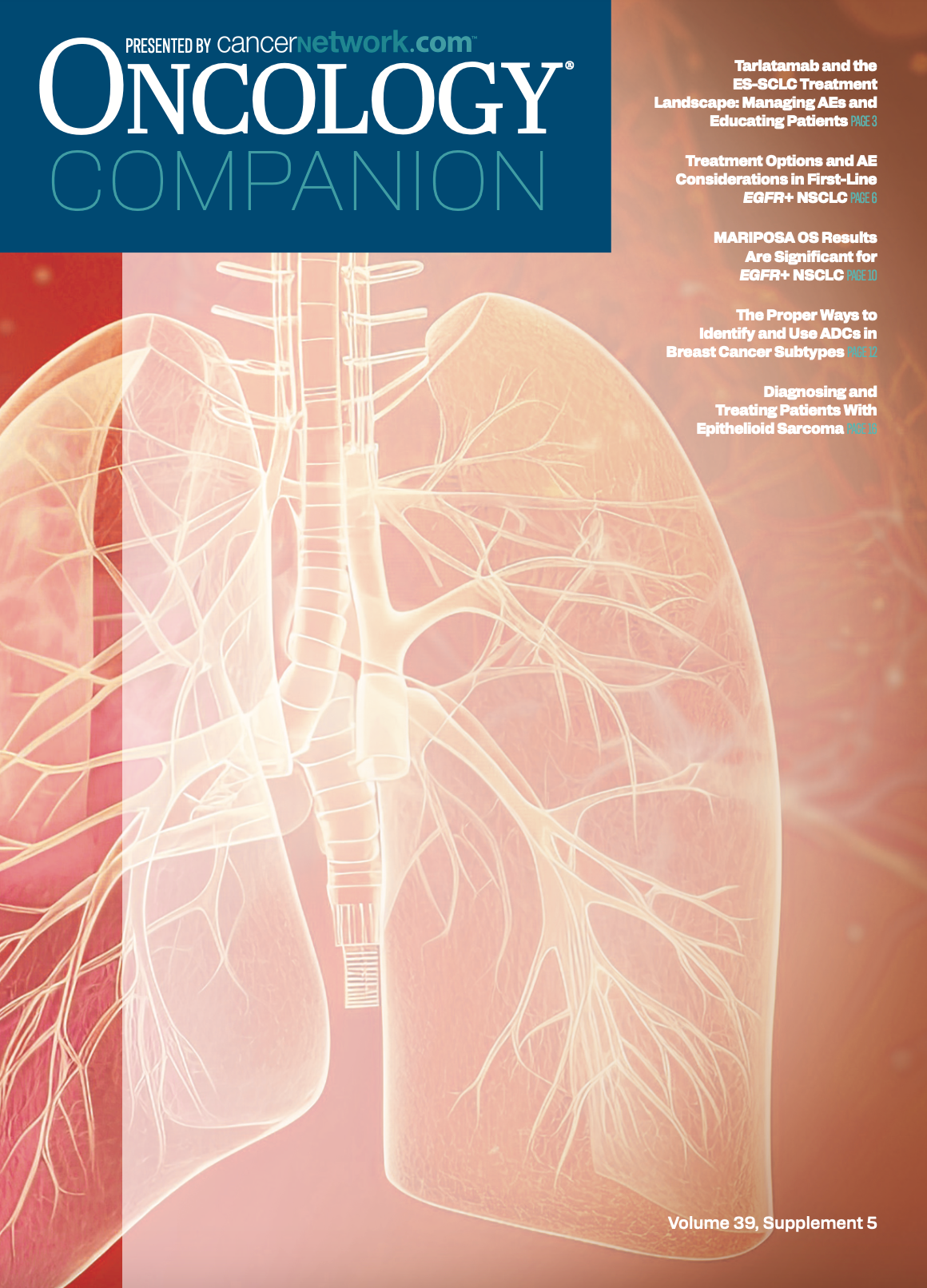MARIPOSA OS Results Are Significant for EGFR+ NSCLC
The MARIPOSA trial revealed promising survival benefits with amivantamab plus lazertinib vs osimertinib for patients with EGFR-mutant lung cancer.
The MARIPOSA trial revealed promising survival benefits with amivantamab plus lazertinib vs osimertinib for patients with EGFR-mutant lung cancer.

During a Between the Lines program at the European Lung Cancer Conference 2025 in Paris, France, the phase 3 MARIPOSA trial (NCT04487080) assessing amivantamab-vmjw (Rybrevant) plus lazertinib (Lazcluze) vs osimertinib (Tagrisso) for patients with non–small cell lung cancer (NSCLC) harboring EGFR exon 19 deletions or L858R mutations was the center of discussion.
Dietrich and Herbst spoke about the trial results, the decision to use this combination regimen over others in the space, and the adverse effect (AE) profile. Martin Dietrich, MD, PhD, is a medical oncologist at Cancer Care Centers of Brevard, The US Oncology Network, and assistant professor of internal medicine at the University of Central Florida. Roy S. Herbst, MD, PhD, is Ensign Professor of Medicine, professor of pharmacology, deputy director of the Yale Cancer Center, chief of hematology/medical oncology at Yale Cancer Center and Smilow Cancer Hospital, assistant dean for translational research, and program director of Master of Health Science-Clinical Investigation Track at Yale School of Medicine.
MARIPOSA Trial
Patients were randomly assigned 2:2:1 to either arm A (n = 429), which included 1050 mg/1400 mg of amivantamab intravenously every week for cycle 1 and every 2 weeks thereafter plus 240 mg of lazertinib orally every day, arm B (n = 429) of 80 mg of oral osimertinib each day, or arm C (n = 216) of 240 mg of oral lazertinib. In arm A, patients were given the 1050-mg dose if they had a weight of less than 80 kg and the 1400-mg dose if they had a weight of 80 kg or more.
Overall survival (OS) was not reached (NR; 95% CI, 42.9-NR) in the combination arm and 36.7 months (95% CI, 33.4-41.0) in the osimertinib arm (HR, 0.75; 95% CI, 0.61-0.92; P < .005). At 24 months, the OS rates were 75% and 70%; at 36 months, they were 60% and 51%; and at 42 months, they were 56% and 44% in the combination and osimertinib arms, respectively.
“We knew that there was already a positive progression-free survival [PFS] benefit from this combination, and we’ve just been waiting on the OS. What you see is that the curves cross early, and they separate, and they remain separate and continue to separate even more as you go forward,” Herbst said. “The HR of 0.75, that’s something that I think all of us would consider clinically meaningful in lung cancer.”
Dietrich asked Herbst how he planned to integrate this combination into his clinical practice. Herbst emphasized the shared decision-making model he uses with his patients. The amivantamab combination requires more office visits and has more AEs, but Herbst believes his patients would gravitate to this regimen because of the survival data.
The median intracranial PFS was 24.4 months (95% CI, 20.1-29.5) in the amivantamab/lazertinib arm and 22.2 months (95% CI, 18.4-26.9) in the osimertinib arm (HR, 0.79; 95% CI, 0.61-1.02; P = .07). The median follow-up was 37.8 months. At 24 months, the PFS rates were 51% and 48%, and at 36 months, they were 36% and 18%.
The median intracranial duration of response was 35.7 months (95% CI, 25.8-NR) in the combination arm and 29.6 months (95% CI, 23.9-34.1) in the monotherapy arm. The intracranial objective response rate was 78% (95% CI, 71%-84%) vs 77% (95% CI, 71%-83%), respectively.
When looking at the curves for PFS, Herbst noted that the results are significant. However, just after the 42-month analysis, a plateau occurs in the amivantamab/lazertinib arm. Dietrich jumped in, saying there are not a lot of data surrounding why this could occur, but Herbst hypothesized it may be from c-MET upregulation.
“We’ve seen similar data trends by intracranial duration of response. There’s a stabilization until just about the 2-year time mark and a very decisive separation of these 2 curves. The intracranial response rates are not augmented with the addition of amivantamab, but we clearly see an improvement in durability. There is a 6-month benefit from amivantamab plus lazertinib over osimertinib. Clearly, a durability factor, not necessarily a factor that improves immediate responses, but we do see a trend for deeper responses in the brain,” Dietrich said.
Herbst responded, saying this is something that is observed with newer classes of drugs. Although there might not be a measurable difference, there is often a longer duration of stability, which can lead to improved survival.
Patients with EGFR mutations might also need to receive radiation therapy. Although Herbst tries to avoid that, in approximately 10% to 15% of his patients, he sees tumors of 2 cm or more in locations that require radiation.
Adverse Effects
The median duration of treatment was 27.0 months for the amivantamab/lazertinib arm and 22.4 months for the osimertinib arm. In the amivantamab/lazertinib and osimertinib arms, any-grade AEs related to EGFR inhibition were paronychia (69% vs 30%), rash (64% vs 32%), diarrhea (32% vs 47%), and dermatitis acneiform (30% vs 13%); any-grade AEs related to MET inhibition were hypoalbuminemia (51% vs 7%) and peripheral edema (38% vs 7%); and other any-grade AEs were infusion-
related reaction (65% vs 0%), alanine transaminase level increase (40% vs 15%), aspartate aminotransferase level increase (33% vs 16%), and constipation (31% vs 16%).
Dietrich highlighted the “substantial” increase in skin toxicities as well as the MET-related AEs. He asked Herbst how he interpreted these data.
“The thing that was unique here was some of the venous thromboembolism, which is a unique reaction and interaction you get when you use the lazertinib with the amivantamab,” Herbst said. “There was another presentation at the meeting of a protocol that’s looking at how to treat the dermatologic AEs, how to treat the scalp, how to treat the nails, and so forth. Also, [it is about] how to be proactive about some of the thromboembolism events. In talking to people around the room, I get the sense that people who’ve used this a lot are becoming comfortable and learning how to treat [these AEs]. It’s about survival, and if you can improve the survival and manage the AEs, then you can work through these different areas.”
The protocol was amended to include prophylactic anticoagulation, according to Dietrich. Because of venous thromboembolism, they were given this protocol for the first 4 months. Herbst highlighted that his group sticks to the recommended 4 months of treatment.
However, identifying these AEs can be a challenge. To properly identify them and prepare for AE management, Herbst noted the high need for education for both clinicians and patients.
Final Remarks
Herbst believes the right strides are being made in this field. He reiterated the importance of the HR of 0.75. He noted there are still areas to figure out, but he is optimistic about seeing what the future holds.
For Dietrich, the ability to have this regimen with a PFS and a long OS shows that this could be a principal therapy in EGFR-mutated lung cancer. “We don’t have the luxury to save good therapies for later. We have to deploy them early and ideally in a curative-intense setting, if possible. This is true for every disease we treat. It’s very important,” Dietrich said.
Reference
Yang JCH, Kim YJ, Lee SH, et al. Amivantamab plus lazertinib vs osimertinib in first-line EGFR-mutant advanced NSCLC. Presented at: European Lung Cancer Congress 2025; March 26-29, 2025; Paris, France. Abstract 4O.
